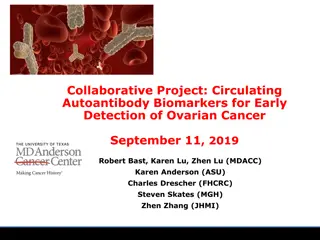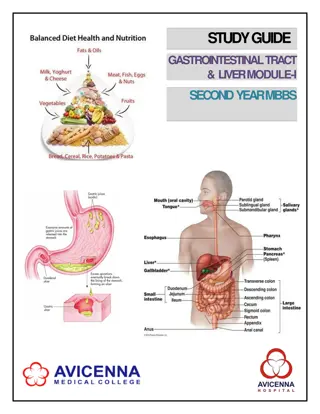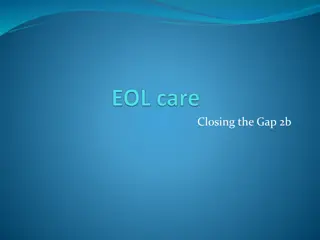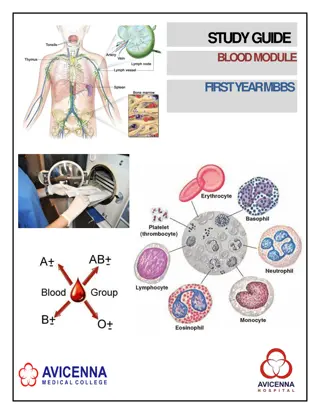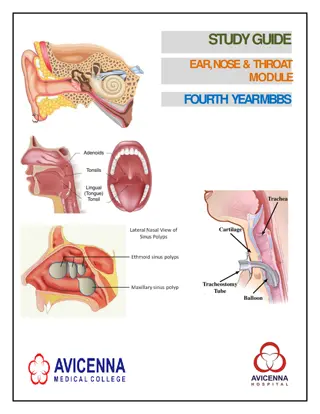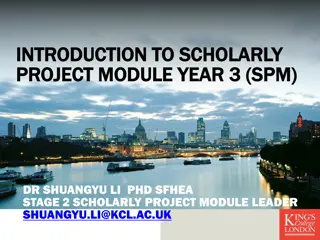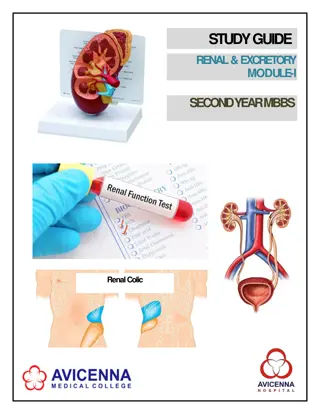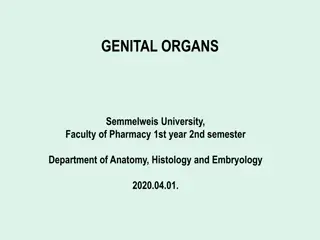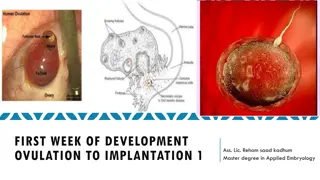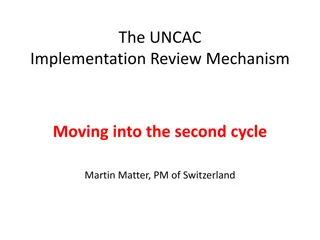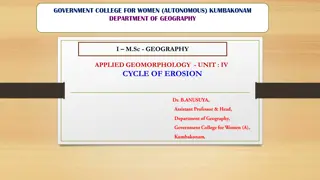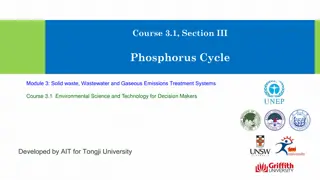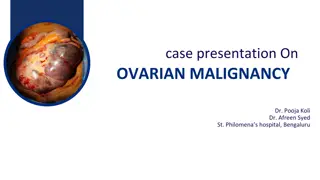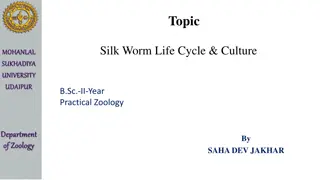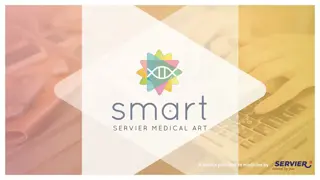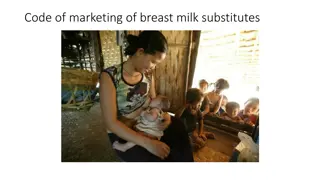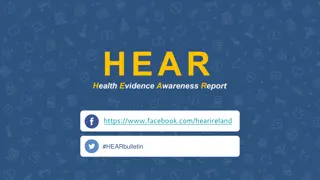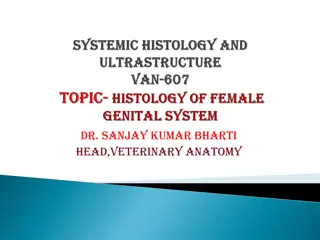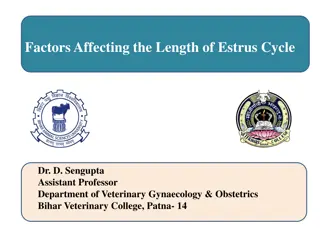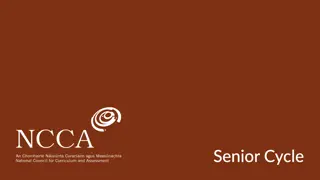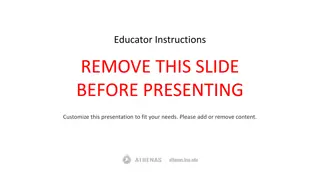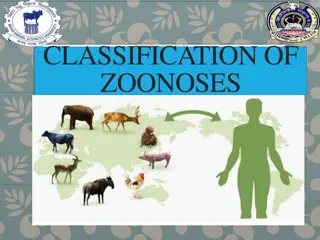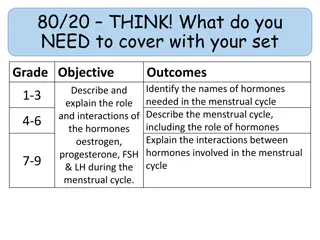Understanding the Ovarian Cycle in Second Year MBBS - Study Guide
This study guide for the Reproductive System Module-I in Second Year MBBS at Avicenna Medical College provides a comprehensive overview of the ovarian cycle, learning methodologies, assessment methods, and curriculum framework. It includes details on the importance of the reproductive system, objectives, resources, examination rules, and regulations. The guide aims to inform and assist students in organizing their studies, achieving module objectives, and excelling in their assessments.
Download Presentation

Please find below an Image/Link to download the presentation.
The content on the website is provided AS IS for your information and personal use only. It may not be sold, licensed, or shared on other websites without obtaining consent from the author. Download presentation by click this link. If you encounter any issues during the download, it is possible that the publisher has removed the file from their server.
E N D
Presentation Transcript
STUDYGUIDE REPRODUCTIVESYSTEM MODULE-I SECOND YEARMBBS OvarianCycle
2nd YEAR MBBS, REPRODUCTIVE SYSTEMMODULE-I AVICENNA MEDICAL COLLEGE STUDY GUIDE FOR REPRODUCTIVE SYSTEMMODULE-I Page No 3 4 5 7 7 8 16 18 20 20 23 S.No CONTENTS 1 2 3 4 4.1 4.2 5 6 7 8 9 Overview Introduction to StudyGuide LearningMethodologies Module 3: ReproductiveSystem-I Importance of ReproductiveSystem Objectives and Learningstrategies LearningResources AssessmentMethods Modular Examination Rules and Regulations(AVMC) Semester Examination Rules and Regulations of UHS Schedule Page | 2
2nd YEAR MBBS, REPRODUCTIVE SYSTEMMODULE-I AVICENNA MEDICAL COLLEGE Year:One Duration: 4 weeks Timetable hours: Lectures, Case-Based Learning (CBL), Team based Learning (TBL), Self-Study, Practical, Skills, Demonstrations, Field Visits, Visit to Wards& Laboratory MODULE INTEGRA TEDCOMMITTEE MODULECOORDINATOR: CO-COORDINATORS: Professor Dr. Zubair Ahmad(Biochemistry) Professor Dr. Rubina Hafeez (Pathology) Professor Dr.Rehana Shahid(Anatomy) DEPARTMENTS & RESOURCE PERSONS FACILITA TINGLEARNING BASIC HEALTHSCIENCES CLINICAL AND ANCILLARYDEPARTMENTS FAMILYMEDICINE Professor Dr. Muhammad Luqman ANATOMY Professor Dr.Rehana Shahid BIOCHEMISTRY Professor Dr. Zubair Ahmad MEDICALEDUCATION Professor Dr. Waheed Ahmad COMMUNITYMEDICINE Professor Dr. Rana Muhammad Akhtar Khan INTERNALMEDICINE Dr. Muhammad Usman Amir PATHOLOGY Endocrinology Prof. Dr. Waheed Ahmed Professor Dr. Rubina Hafeez PHYSIOLOGY Professor Dr. Binyamin Ahmad PHARMACOLOGY Professor Dr. Rana Tariq Mehmood AVMCMANAGEMENT Professor Dr. Gulfreen Waheed, PrincipalAVMC Brig.Dr. Gul e Rana , Director AVMC Dr. Sadia Awan Dr. Muhammad Muzzammil Sadiq Dr. Usama Bin Ishtiaq STUDY GUIDE COMPILEDBY: Department of Health CareEducation Page | 3
2nd YEAR MBBS, REPRODUCTIVE SYSTEMMODULE-I AVICENNA MEDICAL COLLEGE INTRODUCTION WHAT IS A STUDYGUIDE? It is an aidto: Inform students how student learning program of the semester-wise module has been organized Helpstudentsorganize andmanagetheirstudiesthroughoutthemodule Guide students on assessment methods, rules andregulations THE STUDYGUIDE: Communicates information on organization and management of themodule. Thiswill helpthestudentto contactthe rightpersonin caseof anydifficulty. Definestheobjectiveswhich areexpectedto beachieved at theendof themodule. Identifies the learning strategies suchasInteractive Lectures,smallgroupteachings, clinical skills, demonstration, tutorial and casebasedlearning that will be implemented to achieve the module objectives. Provides a list of learning resources such as books, computer assisted learning programs, web- links,journals,forstudentsto consultin orderto maximize their learning. Highlights information on the contribution of continuous and semester examinations on the student s overallperformance. Includes information on the assessment methods that will be held to determine every student s achievement ofobjectives. Focuses on information pertaining toexamination policy, rules and regulations. CURRICULUMFRAMEWORK Students will experience integrated curriculum in 4th semesters at LNMC in accordance with theJSMU guidelines and most recent developments that have an impact on individual health. INTEGRATED CURRICULUM comprises of system-based modules such as GIT & Liver-I, Renal & Excretory System-I and Reproductive System-I which links basic science knowledge to clinical problems. Integrated teaching means that subjects are presented as a meaningful whole. Students will be able to have betterunderstandingof basicscienceswhentheyrepeatedlylearn in relation to clinical examples. Case-based discussions, computer-based assignments, early exposure to clinics, wards, and skills acquisition in skills lab and physiotherapy department are characteristics of integrated teachingprogram. Page | 4
2nd YEAR MBBS, REPRODUCTIVE SYSTEMMODULE-I AVICENNA MEDICAL COLLEGE INTEGRA TING DISCIPLINES OF REPRODUCTIVE SYSTEMMODULE-I LEARNINGMETHODOLOGIES Thefollowing teaching/ learningmethodsareusedto promotebetterunderstanding: InteractiveLectures Hospital / Clinic visits Small Group Discussion Case-BasedLearning Practicals Skillssession E-Learning Self-DirectedLearning TBL INTERACTIVELECTURES In large group, the Interactive Lecturer introduces a topic or common clinical conditions and explains the underlying phenomena through questions, pictures, videos of patients interviews, exercises, etc. Students areactivelyinvolved in the learning process. HOSPITALVISITS: In small groups, students observe patients with signsand symptoms in hospital or clinical settings.Thishelpsstudentsto relate knowledge of basicandclinical sciencesof the relevant module. Page | 5
2nd YEAR MBBS, REPRODUCTIVE SYSTEMMODULE-I AVICENNA MEDICAL COLLEGE SMALLGROUPDISCUSSION(SGD):Thisformat helps students to clarify concepts acquire skills or attitudes. Sessions are structured with the help of specific exercises such as patient case, interviews or discussion topics. Students exchangeopinions and apply knowledgegained from Interactive Lectures, tutorials andself study.Thefacilitator role isto askprobing questions,summarize,or rephraseto help clarify concepts. CASE- BASED LEARNING: A small group discussion format where learning is focused around a series of questions based on a clinical scenario. Students discuss and answer the questions applying relevant knowledge gainedin clinical andbasichealth sciencesduring themodule. PRACTICAL: Basic science practicals related to anatomy, biochemistry, pathology, pharmacology and physiologyarescheduledfor studentlearning. SKILLSSESSION:Skills relevant to respective module are observed and practiced where applicable in skills laboratory or DepartmentofPhysiotherapy. SELFDIRECTEDLEARNING:Students assume responsibilities of their own learning through individual study, sharing and discussing with peers, seeking information from Learning Resource Center, teachers and resource persons within and outside the college. Students can utilize the time within the college scheduled hoursofself-study. TEAM BASED LEARNING: Team-based learning (TBL) is a structured form of small-group learning that emphasizes student preparation out of class and application of knowledge in class. Students are organized strategically into diverse teams of 5-7 students that work together throughout the class. Before each session/class, students prepare by reading prior to class. In class students are given different tasks or test where they work asteam. Apart from attending daily scheduled sessions, students too should engage in self-study to ensure that all the objectives arecovered. Page | 6
2nd YEAR MBBS, REPRODUCTIVE SYSTEMMODULE-I AVICENNA MEDICAL COLLEGE SEMESTER 4 MODULE 3 : REPRODUCTIVESYSTEM-I IMPORTANCE: The module focuses on integrating basic health sciences to clinical medicine. It will be taught in a combination of lectures, tutorials, small group learning sessions, practical and skills classes and possibly visits to clinics / wards. The module will explore the normal aswell asthe abnormal physiology of the male andfemale reproductive system. Students will be introduced to avariety of pathologies to facilitate abetter understanding of how the reproductive system is impacted by diseases. It will give the broad overview of the system. Themodule will also addressreproductive hormonal changesassociatedwith different stagesof life correlating pathophysiology with clinical presentation. This will extend students integrative abilities. Video and hands on sessions on basic examination skills will enhance students understanding of the subject/topic. AIMS OF THISMODULE The module aims toprovide: Knowledge and understanding of the structures and functions of the reproductive system and how it responds to changing metabolic needs of the body, organs and tissues, revealing the relevance of suchknowledge to clinicalpractice Knowledge and understanding of the origin and associated risk factors of common diseases of the reproductivesystem Knowledge and preventionof commonhormonal disorders associatedwith the reproductive system Practiceof basicskills used in testingthe functionof thissystemin asimulatedclinical setting Knowledge of drugs used to treatreproductive system diseases Page | 7
2nd YEAR MBBS, REPRODUCTIVE SYSTEMMODULE-I AVICENNA MEDICAL COLLEGE COURSE TOPICS, OBJECTIVES ANDSTRA TEGIES AT the end of the module the students willbe able to: I. ANATOMY TOPICS &OBJECTIVES LEARNINGSTRATEGY 1.1 GROSSANATOMY 1. 1.1 Bony pelvis (Sacrum + Joints ofPelvis) Discuss the features of bonypelvis Describe theboundariesof inlet & outlet Discuss the osteology ofsacrum Identify muscles and ligaments attached tosacrum Differentiate between male and femalepelvis Discuss the important points ofpelvimetry List various types of joints ofpelvis Explaintype, articulations,ligaments&relation of joints of pelvis Listfactorsproviding stability to the joints of pelvis Describetheblood supply,nervesupply & movementsof joints of pelvis 1. 1.2 Pelvic wall, floor &Fascia Describe the anatomy of thepelvic walls Enumerate the muscles of pelvic floor/pelvicdiaphragm Discussthe attachment& actionsof musclesof pelvicfloor/pelvicdiaphragm Discuss the blood supply, nerve supply& lymphatic drainage of pelvic floor muscles Describe the attachment and significance of pelvicfascia Discussthe clinical conditionsassociated with the pelvic floor& fascia Discussthe role of pelvicfloorin urinaryandfecalcontinence 1. 1.3 Gross Anatomy of Testes andducts Describe the anatomy of thetestes Describe the anatomy ofductus deferens &epididymus& ejaculatory duct 1. 1.4 Prostate, Seminal vesicles & Bulbourethralglands Describethegross featuresof following maleinternal organs: i. Prostategland ii. Seminal Vesicles iii. Bulbourethral glands Discuss their location, relations, blood supply, nerve supply &lymphatic drainage Discuss the clinical conditions associated with prostate gland, seminalvesicles & bulbourethralglands Small GroupDiscussion InteractiveLecture InteractiveLecture InteractiveLecture Page | 8
2nd YEAR MBBS, REPRODUCTIVE SYSTEMMODULE-I AVICENNA MEDICAL COLLEGE 1. 1.5 Gross anatomy of female genital tract, ovary and fallopiantube Identifythelocationof ovary& fallopian tube Describe theparts& functionsof fallopian tube Explain the ligaments of ovary &fallopian tube DescribetheBloodsupply,nervesupply& lymphatic drainage of ovary& fallopiantube Discussthe clinical correlatesof ovary& fallopian tube 1. 1.6 Uterus, cervix &vagina Listthe partsof uterus,cervix& vagina Describethelocation& relations of uterus,cervix andvagina with surroundingstructures Describe the ligaments ofuterus Discussthe blood supply, nervesupply&lymphatic drainage of uterus,cervix & vagina Discuss the clinical conditions associated withuterus, cervix and vagina 1. 1.7 Blood Supply of pelvis, Internal Iliac artery and itsbranches Describetheoriginandcourseof theinternalIliacartery List the branches and area of supplyof: i. Anteriortrunkof Internaliliac artery ii. Posterior trunk ofInternal iliac artery Discuss the relations of internal iliacartery 1. 1.8 Venous & Lymphatic drainage of Pelviccavity Describethemainveins ofthe pelvis andtheirtributaries Name the area of pelvis drained by theseveins Describedifferentgroupsof lymphnodeslocatedinthepelviccavity Describe theafferentandefferentpathwaysof differentgroupsof lymph nodes of the pelviccavity Explaintherole of lymphaticsandcommonrouteof spread of malignancies of pelvis 1. 1.9 Nerves of Pelvis & Perineum + Sacralplexus Enumerate the nerves innervatingpelvis Describe Sacral plexus and explain itsformation Describe the branches and divisions ofsacral plexus Identify coccygealplexus Describe hypogastric plexus, its location, formation and itsbranches Discussthe injuriesassociatedwith the nervesof pelvis,perineumandsacral plexus 1. 1.10 Perineum-I Describe the gross anatomical features ofperineum List the boundaries ofperineum Describethedivision of perineum into analandurogenital triangles InteractiveLecture/Small GroupDiscussion InteractiveLecture InteractiveLecture InteractiveLecture InteractiveLecture InteractiveLecture/Small GroupDiscussion Page | 9
2nd YEAR MBBS, REPRODUCTIVE SYSTEMMODULE-I AVICENNA MEDICAL COLLEGE Discuss the boundaries and features ofanal triangle Discussthe importance of pectinate line with respectto thevasculature and lymphatic drainage of therectum and anal canal Discuss the blood supply, nerve supply and lymphatic drainage ofthe perineum 1. 1.11 Perineum- II Describe male urogenital triangle and itscontents Describe the gross anatomy of maleurethra Describetheblood supply, nervesupplyandlymphatic drainageof male urethra Discussthe clinical conditionsassociatedwith penis& maleurethra Describe female urogenital triangle and itscontents 2.HISTOLOGY 1. 2.1 Histology of Prostate, Seminal vesicles & Bulbourethralglands Identifythehistologicalfeaturesunderlightmicroscope of the following: i. Prostategland ii. Seminal Vesicle iii. Bulbourethral glands Listthe componentsof secretionof prostate gland,seminalvesicles& bulbourethral glands Discuss the composition ofSemen 1. 2.2 Histology of ovary & fallopiantube Describe the histological features offollowing; i. Ovaries & ovarianfollicles ii. Epithelium of fallopiantube iii. Walls of fallopiantube 1. 2.3 Histology of Uterus, Cervix andVagina Describe the histological featuresof: i. Uterus ii. Wallsof theuterus;perimetrium,myometrium,endometrium iii. Lining epithelium ofuterus iv. Cells found in the uterineendometrium v. Briefly discuss the phases of menstrualcycle Describethehistologicalfeaturesandpartsof cervix& vagina 1. 2.4 Histology of testes and ductsystem List the male reproductiveorgans Describethehistologicalfeaturesof testesandmalegenital ductsystem Describe the histology ofseminiferous tubules, sertoli cells, spermatozoa, leydig cells, rete testis andepididymis. Identifythehistologicalfeaturesof testisandductsystem InteractiveLecture/Small GroupDiscussion InteractiveLecture/Small GroupDiscussion Interactive Lecture/Practic al InteractiveLecture/Small GroupDiscussion Interactive Lecture/Practic al Interactive Lecture/Practic al Interactive Lecture/Practic al Page | 10
2nd YEAR MBBS, REPRODUCTIVE SYSTEMMODULE-I AVICENNA MEDICAL COLLEGE 3.EMBRYOLOGY 1. 3.1 Development of male reproductivesystem List the time line in which the development of male reproductivesystem starts andends Describetheprocess of developmentof partsof malereproductive system Discuss the development of male external genitalia Discussthe congenitalanomaliesresulting dueto malformationof male genital system i. Cryptorchidism (un-descendedtestes) ii. Hypospadiasis and other malformation ofurethra 1. 3.2 Development of Female reproductivesystem Discuss the primordial germ cells, theirprecursors and migration Describe thelocationanddivision of genital ridges Describe the development of female genitalducts Discuss the development and differentiation ofParamesonephric ducts with development of uterus andvagina Discussthe congenitalanomaliesassociatedwith themalformationof female reproductivesystem InteractiveLecture/Small GroupDiscussion InteractiveLecture/Small GroupDiscussion II. BIOCHEMISTRY TOPICS &OBJECTIVES LEARNINGSTRATEGY 2.1 Male SexHormone Describe the synthesis, regulation and functions of male sex hormonesand abnormalities 2.2 Female sexhormone Explain the synthesis, regulation and functions of female sex hormonesand relatedabnormalities 2.3 Pituitary Hormone and MenstrualCycle Explainthehormonalchangesat menarcheandtheirrelationship to the menstrualcycle 2.4 Biochemical changes duringmenopause Describe the biochemical changes and complications duringmenopause 2.5 Biochemical role ofPlacenta Explain the biochemical role of placenta and its hormonal secretions (AFP& -HCG) 2.6 Amniotic fluidAnalysis Discussthe normal constituents of amniotic fluid andtheBiochemical markers of fetaldevelopment 2.7 Genetics Discuss the chemical structure of DNA & RNA and geneticdisorders. Explain theprocessof Replicationandthe relatedabnormalities InteractiveLecture InteractiveLecture Small GroupDiscussion Small GroupDiscussion Small GroupDiscussion InteractiveLecture InteractiveLecture Page | 11
2nd YEAR MBBS, REPRODUCTIVE SYSTEMMODULE-I AVICENNA MEDICAL COLLEGE Discussthe processof Transcriptionandexplainretroviruses in relation with Cancer and AIDs and the effect ofdrugs Explain Translation and post translational modifications and discussdifferent types ofmutations Explain how gene expression iscontrolled Discuss Recombinant DNA technology and its uses 2.8 Pregnancytest Perform urine pregnancy test by using dip stick( -HCG levels) 2.9 PCR Describe PCR and itsapplications III. TOPICS &OBJECTIVES 3.1 Introduction to Reproductive Health Describe the components of reproductivehealth Discuss the reproductive health policy ofPakistan 3.2 Maternalcare Explain the determinants for maternalcare Identify the high risk group duringpregnancy Describe thecontrolmeasuresforpreventionof mothersduring pregnancy 3.3 InfantCare Discuss the risk factors for infantcare Explain the components of infantcare Discussthe role of mother& of breastfeedingin infantcare Describethecontrolmeasuresforpreventionof infantmortality 3.4 Integrated Management Of Childhood Illness(IMNCI) Describe the components ofIMNCI Discussthe role of community andfamilypracticein IMNCI Explain the process of assessment of danger signs inIMNCI 3.5 FamilyPlanning Describe the methods used in familyplanning List the target couples for familyplanning Explain the family planning policy inPakistan 3.6 Reproductive TractInfections Classify reproductive tractinfections Describe the process of assessment and diagnosis of reproductivetract infections Discuss the syndromic management of reproductive tractinfections 3.7 HIV/AIDs Describe the signs and symptoms ofAIDS Describe thecontrolmeasuresforpreventionof HIV/AIDs Describe HIV/AIDS control programme inPakistan InteractiveLecture Practical Practical COMMUNITYMEDICINE LEARNINGSTRATEGY InteractiveLecture InteractiveLecture/Small GroupDiscussion Small GroupDiscussion InteractiveLecture InteractiveLecture/Small GroupDiscussion InteractiveLecture InteractiveLecture Page | 12
2nd YEAR MBBS, REPRODUCTIVE SYSTEMMODULE-I AVICENNA MEDICAL COLLEGE 3.8 Health Education On ReproductiveHealth Describe the components of healtheducation Discuss the principles of healtheducation Explain the approaches of healtheducation Small GroupDiscussion PATHOLOGY &MICROBIOLOGY TOPICS &OBJECTIVES IV. LEARNINGSTRATEGY 4.1 Prostatitis and benign prostatichyperplasia Discuss the various types of prostatitismorphology and microorganisms involved inpathogenesis Describe the etiology pathogenesis, morphology, clinical features ofBenign ProstateHyperplasia 4.2 Congenital anomalies of female genital tract andPIDs Describethevarious congenitalanomaliesof femalegenital tract with their important salientfeatures Discuss the microorganism, pathogenesis, morphology and complicationof Pelvic Inflammatory Diseases (PID) 4.3 Non-neoplastic cysts and functional cyst of ovary and Poly CysticOvaries Discuss the follicular and luteal cysts withmorphology Define Polycystic Ovaries(PCOs) Describe its etiology, pathogenesis, morphology andcomplications 4.4 Congenital anomalies of MGT testicular,epididymo-orchitis Discuss developmental abnormalities and related features of thehypospadias, Epispadias andphimosis Discuss the microorganism, pathogenesis and morphology ofspecific and non-specific typesepididymo-orchitis InteractiveLecture InteractiveLecture InteractiveLecture InteractiveLecture V. PHARMACOLOGY TOPICS &OBJECTIVES LEARNINGSTRATEGY 5.1 Androgens &Anti-androgens Explainkinetics& dynamicsof the hormonesproducedbytestisplus classification, properties & clinical uses ofthese agents 5.2 Estrogens &Anti-estrogens Classify estrogens & antiestrogens Discuss basic & clinical pharmacology of theseagents 5.3 Progestins &Anti-progestins Classify progestins and theirinhibitors Explain basic & clinical pharmacology of progestins and theirinhibitors 5.4 Contraceptives Classify contraceptive drugs Discuss dynamics of different hormonal contraceptivedrugs 5.5 Prolactin inhibitory factors(Bromocriptine) Enumerate Prolactin inhibitoryfactors Explain clinical pharmacology ofBromocriptine InteractiveLecture Small GroupDiscussion Small GroupDiscussion InteractiveLecture InteractiveLecture Page | 13
2nd YEAR MBBS, REPRODUCTIVE SYSTEMMODULE-I AVICENNA MEDICAL COLLEGE 5.6 Effects of different drugs on the ratuterus Observetheeffectsof differentdrugsonratuterususingpowerlab Practical VI. PHYSIOLOGY TOPICS &OBJECTIVES LEARNINGSTRATEGY 6.1 Spermatogenesis, Semen, Capacitation ofSperms Explain the stages ofspermatogenesis Describe the hormonal control ofspermatogenesis 6.2 Male Sex Hormone: Testosterone & itsFunction Describe the synthesis, function and regulation ofmale sex hormones 6.3 Abnormalities of Male SexualAct Discuss the abnormalities of male sexual function (hypo and hypergonadism) 6.4 Functions ofOvary Discuss oogenesis and stages of follicle development through ovulationand formation of corpusrectum 6.5 Puberty, Menstrual Cycle, Menarche&Menopause Describe thesynthesis functionandregulationof hormonesof female reproductivesystem. Describethehormonalchangesthat occurduring puberty,themechanism that controltheoverall of puberty Explain the secondary sexual characteristics that develop during pubertyin males andfemales. Explain now the secretion of FSH and LH is controlled through negativeand positive feedback during menstrualcycle Describe the cyclical changes that occur in endometrium andhormonal mechanism thatchanges 6.6 Pregnancy, Function of Placenta, &Maternal Changes DuringPregnancy List hormones secreted by placenta and theiractions Interpret endocrine assays during the course ofpregnancy Describethephysiological changesduring pregnancywith respectto all organ andsystem Brief describe process of parturition especially (stages,mechanism, hormones) 6.7 Mammary Gland &Lactation Describethehormonalrequirementsfordevelopmentof memorygland during pregnancy and milk ejectionreflexes VII. TOPICS &OBJECTIVES 7.1 Polycystic ovaries and menstrualdisorder Define polycystic ovary Describe the pathophysiology of menstrual cycle and itsabnormalities Describe the clinical features ofpolycystic ovaries Discuss the outline of itsmanagement plan Small GroupDiscussion InteractiveLecture InteractiveLecture InteractiveLecture InteractiveLecture/Small GroupDiscussion InteractiveLecture/Small GroupDiscussion InteractiveLecture OBSTETRICS &GYNECOLOGY LEARNINGSTRATEGY InteractiveLecture Page | 14
2nd YEAR MBBS, REPRODUCTIVE SYSTEMMODULE-I AVICENNA MEDICAL COLLEGE 7.2 AntenatalCare Define Antenatalcare Discuss the concepts oftrimesters Describe the components of Antenatalcare Justify theinvestigations Discuss the significance of Antenatalcare 7.3 Congenital abnormalities related to reproductivetract Define Klinefelter syndrome, Mayer Rokitansky syndrome, Turnersyndrome Describethepathophysiology & clinical featuresof theabovementioned conditions Discuss management outline plan for theseconditions 7.4 Prenataldiagnosis Define prenatalcare Discuss its types (invasive &non-invasive) InteractiveLecture/Small GroupDiscussion InteractiveLecture InteractiveLecture VIII. SKILLLAB TOPICS &OBJECTIVES LEARNINGSTRATEGY 8.1 ProstateExamination Perform prostate examination onmannequin Small GroupHands-On Practice Page | 15
2nd YEAR MBBS, REPRODUCTIVE SYSTEMMODULE-I AVICENNA MEDICAL COLLEGE LEARNINGRESOURCES SUBJECT RESOURCES A. GROSSANATOMY 1. K.L. Moore, Clinically OrientedAnatomy 2. Neuro Anatomy by RichardSnell B. HISTOLOGY 1. B. Young J. W. Health Wheather s FunctionalHistology C. EMBRYOLOGY 1. Keith L. Moore. The DevelopingHuman 2. Langman s Medical Embryology ANATOMY TEXTBOO KS 1. Harper s IllustratedBiochemistry 2. Lehninger Principle ofBiochemistry 3. Biochemistry byDevlin BIOCHEMISTRY TEXTBOOKS 1. Community Medicine byParikh 2. Community Medicine by MIllyas 3. Basic Statistics for the Health Sciences by Jan WKuzma COMMUNITYMEDICINE TEXTBOOKS 1. Robbins & Cotran, Pathologic Basis of Disease, 9thedition. 2. Rapid Review Pathology, 4th edition by Edward F. GoljanMD PATHOLOGY/MICROBIOLOGY 1. http://library.med.utah.edu/WebPath/webpath.html 2. http://www.pathologyatlas.ro/ TEXTBOOKS 1. Lippincot IllustratedPharmacology 2. Basic and Clinical Pharmacology by Katzung PHARMACOLOGY A. TEXTBOOKS 1. Textbook Of Medical Physiology by Guyton AndHall 2. Ganong S Review of MedicalPhysiology 3. Human Physiology by LauraleeSherwood 4. Berne & LevyPhysiology 5. Best & Taylor Physiological Basis of MedicalPractice B. REFERENCEBOOKS 1. Guyton & Hall PhysiologicalReview 2. Essentials Of Medical Physiology byJaypee 3. Textbook Of Medical Physiology byInduKhurana 4. Short Textbook Of Physiology byMrthur 5. NMSPhysiology PHYSIOLOGY Page | 16
2nd YEAR MBBS, REPRODUCTIVE SYSTEMMODULE-I AVICENNA MEDICAL COLLEGE OTHER LEARNINGRESOURCES Students will be involved in Practical sessions and hands-on activitiesthat link with the reproductive systemmoduleto enhancethe learning. Hands-on Activities/Practical Utilize thelabto relatethe knowledge to thespecimensandmodels Labs available. A skills lab provides the simulators tolearn the basic skills and SkillLab procedures. This helps build the confidence to approach thepatients. Videofamiliarize thestudentwith the proceduresandprotocols to assist Videos patients. To increase the knowledge students should utilize the availableinternet resources and CDs/DVDs. This will be an additional advantage to increase learning. Computer Lab/CDs/DVDs/Internet Resources: Self Learning is scheduled to search for information tosolve cases, read through different resources and discuss among the peers and with the faculty to clarify theconcepts. SelfLearning Page | 17
2nd YEAR MBBS, REPRODUCTIVE SYSTEMMODULE-I AVICENNA MEDICAL COLLEGE ASSESSMENTMETHODS: Theory: o Best Choice Questions (BCQs) also known as MCQs (Multiple Choice Questions) are used to asses objectives covered in eachmodule. A BCQ has a statement or clinical scenario followed by four options (likelyanswer). Students after reading the statement/scenario select ONE, the most appropriate response fromthe given list ofoptions. Correct answer carries one mark, and incorrect zero mark . There is no negative marking. Studentsmarktheirresponsesonspecifiedcomputer-based/OMRsheetdesignedfor AVMC EMQs: An EMQhas: o o Anoption list of 5-15 which maybenervesupply, functions,diagnosis,investigationsetc A Lead In Statement/Question o Two to four Stems or ClinicalScenarios Foreachstemorclinical scenario,the studentshouldchoosethemostappropriateoption fromthe o optionlist. Asingle option canbeusedonce,morethanonceornot at all. Correct answer carries one mark and incorrect zero mark . There is NO negativemarking. Student mark their responses on a specified computer-based sheet forEMQs. OSPE/OSCE: Objective Structured Practical/ClinicalExamination: Eachstudentwill beassessedonthe samecontentandhavesametimeto completethe task. Comprise of 12-25stations. Each station may assess a variety of clinical tasks, these tasks may include history taking, physical examination, skills and application of skills andknowledge Stations are observed, unobserved, interactive and reststations. Observed and Interactive Stations: o Theywill beassessedbyinternal orexternalexaminers throughstructuredviva or tasks. Unobserved Stations: o It will be static stations in which there may be an X-ray, Labs reports, pictures, clinical scenarios with relatedquestionsforstudentsto answeronthe provided answer copy. Reststation o It is a station where there is no task given and in this time student can organize his/her thoughts. Page | 18
2nd YEAR MBBS, REPRODUCTIVE SYSTEMMODULE-I AVICENNA MEDICAL COLLEGE LNHMC Internal Evaluation Policy Students will beassessedto determine achievement of moduleobjectivesthroughthefollowing: Module Examination: will be scheduled on completion of each module. The method ofexamination comprises theory exam which includes BCQs, EMQs and OSPE (Objective Structured Practical Examination). Graded Assessment of students by Individual Department: Quiz, viva, practical, assignment, small group activities such as CBL, TBL, TOL, online assessment, ward activities, examination, and logbook. Marksof bothmodular examinationandgradedassessmentwill constitute 20%weightage. As per UHSpolicy, this 20% will be added by UHSto SemesterExamination. Example : Number of JSMU Marks allocated for Semester Theory and Internal Evaluation InternalEvaluation (Task Presentation + Assignments + Modular Exam 20% Semester Examination TheoryMarks Total(Theory) Semester 80% 100% FormativeAssessment Individual department may hold quiz or short answer questions to help students assess their own learning. The marks obtained are not included in the internalevaluation More than 75% attendance is needed to sit for the modular and semester examinations Page | 19
2nd YEAR MBBS, REPRODUCTIVE SYSTEMMODULE-I AVICENNA MEDICAL COLLEGE MODULAR EXAMINATION RULES & REGULATIONS(AVMC) Studentmustreportto examinationhall/venue, 30 minutesbeforetheexam. Exam will begin sharp at the giventime. No student will be allowed to enter the examination hall after 15 minutes of scheduled examinationtime. Studentsmust sitaccordingto theirroll numbersmentioned ontheseats. Cell phones are strictly not allowed in examinationhall. If anystudentisfoundwith cell phonein anymode(silent, switchedoff oron)he/shewill benot be allowed to continue theirexam. No students will be allowed to sit in exam without University Admit Card, AVMCCollege ID Card and LabCoat Student must bring the following stationary items for the exam: Pen, Pencil, Eraser, and Sharpener. Indiscipline in the exam hall/venue is not acceptable. Students must not possess any written materialorcommunicatewith theirfellowstudents. Page | 20
2nd YEAR MBBS, REPRODUCTIVE SYSTEMMODULE-I AVICENNA MEDICAL COLLEGE ExaminationProtocols: In each semester , module will be assessed by theory paper com prisingMCQs and EMQs. For example semester 4 will have separate theory paper of GIT and Liver, Renal and Excretory, Reproductive systemmodules. There will be one OSPE (Objective Structured Practical Examination)/OSCE (Objective Structured Clinical Examinations) which will cover all threemodulesof semesterfour. 1. Theory Theory paper will comprise of80 one best type MCQs and 20 EMQs. Timeduration fortheorypaperwill be120minutes. Students will mark their responses on UHSspecified response sheets assessed by computer software. It will carryout 80%contributionintheoryresultsof the Semester. There is no negativemarking. 2. OSPE/OSCE: It maycomprisebetween12-25stations.Eachstationwill carry10marks. 3. UHS GradingSystem It will be based on GPA 4system Marks obtained in Percentagerange NumericalGrade AlphabeticalGrade 80-100 4.0 A+ 75-79 4.0 A 70-74 3.7 A- 67-69 3.3 B+ 63-66 3.0 B 60-62 2.7 B- 56-59 2.3 C+ 50-55 2.0 C <50 Un-grade-able 0 U A candidate obtaining GPA less than 2.00 (50%) is declared un-graded(fail). Cumulativetranscriptisissuedat the endof clearance of all modules. Page | 21
2nd YEAR MBBS, REPRODUCTIVE SYSTEMMODULE-I AVICENNA MEDICQAL COLLEGE 4. RetakeExamination Retakeexaminations are for those students who fail in semester examinations and those who have passedsemester examinations with GPAlessthan 3.0 mayreappear in respective retake examination to improvegrades. The format of the retake examination is exactly the same as insemester examinations. Retakeexaminationwill beconducted3weeksafterdeclarationof results. 5. Promotion to nextclass Studentswho passbothsemesterexaminations arepromotedfromfirstyearto secondyear. Students who fail the MBBS first year semester retake examination will be promoted to second year. Students will be promoted from second year to third year and onward only if they have passed thesemesterexaminationsof thatyear. Clearance of all modules and their components of semester one to four are mandatory for promotion from second year tothird year (as per PMDC rules). As per PMDC rules any candidate failing to clear a module or its component in four (1+3) attemptsisNOTallowed to carryout furthermedicaleducation. Clearance of all modules and their components of semester/s are mandatory for promotion from third yearonward. Page | 22



